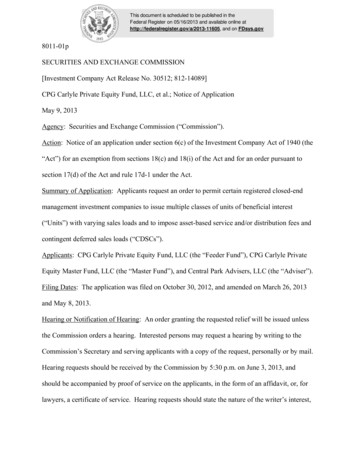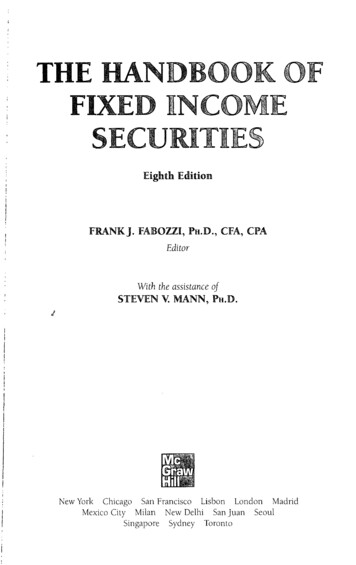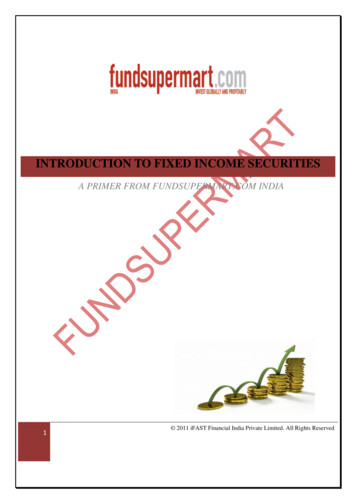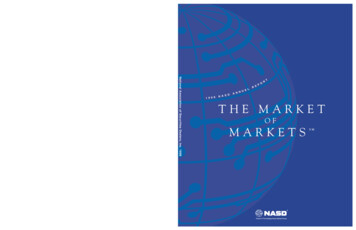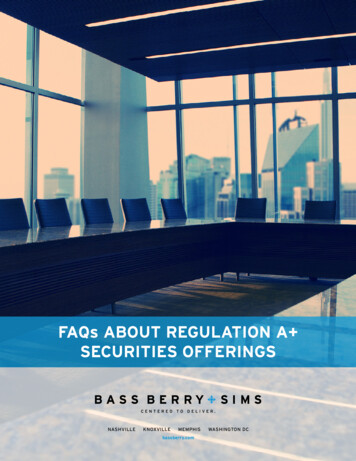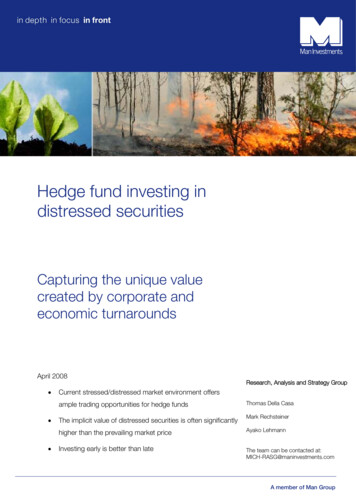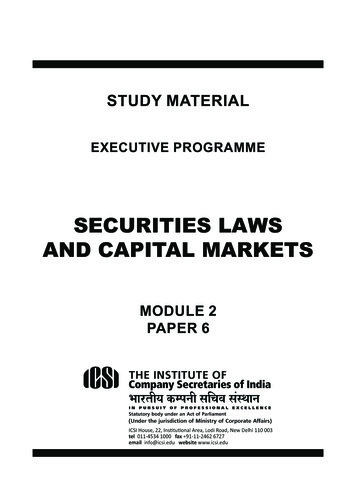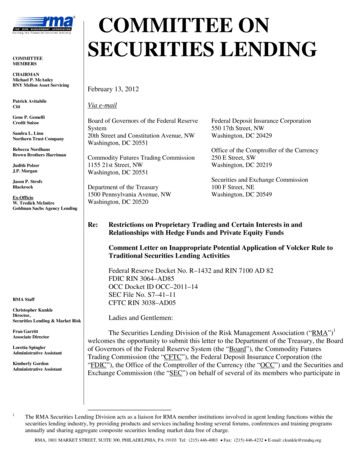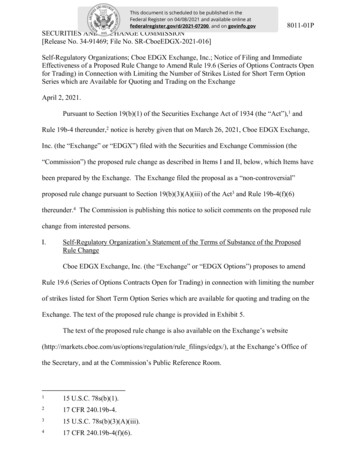
Transcription
This document is scheduled to be published in theFederal Register on 04/08/2021 and available online atfederalregister.gov/d/2021-07200, and on govinfo.gov8011-01PSECURITIES AND EXCHANGE COMMISSION[Release No. 34-91469; File No. SR-CboeEDGX-2021-016]Self-Regulatory Organizations; Cboe EDGX Exchange, Inc.; Notice of Filing and ImmediateEffectiveness of a Proposed Rule Change to Amend Rule 19.6 (Series of Options Contracts Openfor Trading) in Connection with Limiting the Number of Strikes Listed for Short Term OptionSeries which are Available for Quoting and Trading on the ExchangeApril 2, 2021.Pursuant to Section 19(b)(1) of the Securities Exchange Act of 1934 (the “Act”),1 andRule 19b-4 thereunder,2 notice is hereby given that on March 26, 2021, Cboe EDGX Exchange,Inc. (the “Exchange” or “EDGX”) filed with the Securities and Exchange Commission (the“Commission”) the proposed rule change as described in Items I and II, below, which Items havebeen prepared by the Exchange. The Exchange filed the proposal as a “non-controversial”proposed rule change pursuant to Section 19(b)(3)(A)(iii) of the Act3 and Rule 19b-4(f)(6)thereunder.4 The Commission is publishing this notice to solicit comments on the proposed rulechange from interested persons.I.Self-Regulatory Organization’s Statement of the Terms of Substance of the ProposedRule ChangeCboe EDGX Exchange, Inc. (the “Exchange” or “EDGX Options”) proposes to amendRule 19.6 (Series of Options Contracts Open for Trading) in connection with limiting the numberof strikes listed for Short Term Option Series which are available for quoting and trading on theExchange. The text of the proposed rule change is provided in Exhibit 5.The text of the proposed rule change is also available on the Exchange’s ion/rule filings/edgx/), at the Exchange’s Office ofthe Secretary, and at the Commission’s Public Reference Room.115 U.S.C. 78s(b)(1).217 CFR 240.19b-4.315 U.S.C. 78s(b)(3)(A)(iii).417 CFR 240.19b-4(f)(6).
II.Self-Regulatory Organization’s Statement of the Purpose of, and Statutory Basis for, theProposed Rule ChangeIn its filing with the Commission, the Exchange included statements concerning thepurpose of and basis for the proposed rule change and discussed any comments it received on theproposed rule change. The text of these statements may be examined at the places specified inItem IV below. The Exchange has prepared summaries, set forth in sections A, B, and C below,of the most significant aspects of such statements.A.Self-Regulatory Organization’s Statement of the Purpose of, and Statutory Basisfor, the Proposed Rule Change1.PurposeThe Exchange proposes to amend Rule 19.6 (Series of Options Contracts Open forTrading). Specifically, this proposal seeks to widen the intervals between strikes in order to limitthe number of strikes listed for multiply listed equity options classes (excluding options onExchange-Traded Funds (“ETFs”) and Exchange-Traded Notes (“ETNs”)) within the Short TermOption Series program that have an expiration date more than 21 days from the listing date.BackgroundCurrent Rule 19.6 permits the Exchange, after a particular class of options has beenapproved for listing and trading on the Exchange, to open for trading series of options therein.
The Exchange may list series of options for trading on a weekly,5 monthly6 or quarterly7 basis.Rule 19.6.01 sets forth the intervals between strike prices of series of options on individualstocks generally,8 and Rule 19.6.05(e) specifically sets forth intervals between strike prices on5The weekly listing program is known as the Short Term Option Series Program and isdescribed within Rule 19.6.05.6The Exchange will open at least one expiration month for each class of options open fortrading on the Exchange. See Rule 19.6(e). The monthly expirations are subject to certainlisting criteria for underlying securities described within Rule 19.3. Monthly listingsexpire the third Friday of the month. The term “expiration date” when used in respect of aseries of binary options other than event options means the last day on which the optionsmay be automatically exercised. In the case of a series of event options (other than creditdefault options or credit default basket options) that are be automatically exercised priorto their expiration date upon receipt by the Corporation of an event confirmation, theexpiration date is the date specified by the listing Exchange; provided, however, thatwhen an event confirmation is deemed to have been received by the Corporation withrespect to such series of options, the expiration date will be accelerated to the date onwhich such event confirmation is deemed to have been received by the Corporation orsuch later date as the Corporation may specify. In the case of a series of credit defaultoptions or credit default basket options, the expiration date is the fourth business dayafter the last trading day for such series as such trading day is specified by the Exchangeon which the series of options is listed; provided, however, that when an eventconfirmation is deemed to have been received by the Corporation with respect to a seriesof credit default options or single payout credit default basket options prior to the lasttrading day for such series, the expiration date for options of that series will beaccelerated to the second business day following the day on which such eventconfirmation is deemed to have been received by the Corporation. “Expiration date”means, in respect of a series of range options expiring prior to February 1, 2015, theSaturday immediately following the third Friday of the expiration month of such series,and, in respect of a series of range options expiring on or after February 1, 2015 meansthe third Friday of the expiration month of such series, or if such Friday is a day on whichthe Exchange on which such series is listed is not open for business, the preceding day onwhich such Exchange is open for business. See The Options Clearing Corporation(“OCC”) By-Laws at Section 1.7The quarterly listing program is known as the Quarterly Options Series Program and isdescribed within Rule 19.6.04.8The interval between strike prices of series of options on individual stocks may be 2.50or greater where the strike price is 25 or less, provided however, that EDGX Optionsmay not list 2.50 intervals below 50 (e.g. 12.50, 17.50) for any class included withinthe 1 Strike Price Program, as detailed below in Interpretations and Policy .02, if theaddition of 2.50 intervals would cause the class to have strike price intervals that are 0.50 apart. For series of options on 283 Exchange-Traded Fund Shares that satisfy thecriteria set forth in Rule 19.3(i), the interval of strike prices may be 1 or greater wherethe strike price is 200 or less or 5 or greater where the strike price is over 200.Exceptions to the strike price intervals above are set forth in Interpretations and Policies.02 and .03. See Rule 19.6.01.
Short Term Option Series. Additionally, the Exchange may list series of options pursuant to the 1 Strike Price Interval Program,9 the 0.50 Strike Program,10 the 2.50 Strike Price Program,11and the 5 Strike Program.12The Exchange’s proposal seeks to amend the listing of weekly series of options (i.e. ShortTerm Option Series) by adopting new Rule 19.6.05(f),13 which widens the permissible intervalsbetween strikes, thereby limiting the number of strikes listed, for multiply listed equity options9The 1 Strike Interval Program is described within Rule 19.6.02.10The 0.50 Strike Program is described within Rule 19.6.06.11The 2.50 Strike Price Program is described within Rule 19.6.03.12The 5 Strike Program is described within Rule 19.6(d)(5).13As a result, the proposed rule change subsequently updates current Rule 19.6.05(f) and(g) to (g) and (h), respectively.
(excluding options on ETFs14 and ETNs15) that have an expiration date more than 21 days from14The term “ETF” (Exchange-Traded Fund) (or “Fund Shares”) has the same meaning asthe term “exchange-traded fund” as defined in Rule 6c-11 under the Investment CompanyAct of 1940. See Rule 14.2(c)(2); see also Rule 19.3(i). Securities deemed appropriate foroptions trading shall include shares or other securities (“Fund Shares”), including but notlimited to Partnership Units as defined in this Rule, that are principally traded on anational securities exchange and are defined as an “NMS stock” under Rule 600 ofRegulation NMS, and that (1) represent interests in registered investment companies (orseries thereof) organized as open-end management investment companies, unitinvestment trusts or similar entities, and that hold portfolios of securities comprising orotherwise based on or representing investments in indexes or portfolios of securities (orthat hold securities in one or more other registered investment companies that themselveshold such portfolios of securities) (“Funds “) and/or financial instruments including, butnot limited to, stock index futures contracts, options on futures, options on securities andindexes, equity caps, collars and floors, swap agreements, forward contracts, repurchaseagreements and reverse repurchase agreements (the “Financial Instruments”), and moneymarket instruments, including, but not limited to, U.S. government securities andrepurchase agreements (the “Money Market Instruments”) constituting or otherwisebased on or representing an investment in an index or portfolio of securities and/orFinancial Instruments and Money Market Instruments, or (2) represent commodity poolinterests principally engaged, directly or indirectly, in holding and/or managing portfoliosor baskets of securities, commodity futures contracts, options on commodity futurescontracts, swaps, forward contracts and/or options on physical commodities and /or nonU.S. currency (“Commodity Pool ETFs”) or (3) represent interests in a trust or similarentity that holds a specified non- U.S. currency or currencies deposited with the trust orsimilar entity when aggregated in some specified minimum number may be surrenderedto the trust by the beneficial owner to receive the specified non-U.S. currency orcurrencies and pays the beneficial owner interest and other distributions on the depositednon-U.S. currency or currencies, if any, declared and paid by the trust (“Currency TrustShares”), or (4) represent interests in the SPDR Gold Trust or are issued by the iSharesCOMEX Gold Trust or iShares Silver Trust).15Securities deemed appropriate for options trading shall include shares or other securities(“Equity Index-Linked Securities,” “Commodity-Linked Securities,” “Currency-LinkedSecurities,” “Fixed Income Index-Linked Securities,” “Futures-Linked Securities,” and“Multifactor Index-Linked Securities,” collectively known as “Index- Linked Securities”)(or “ETNs”) that are principally traded on a national securities exchange and an “NMSStock” (as defined in Rule 600 of Regulation NMS under the Securities Exchange Act of1934), and represent ownership of a security that provides for the payment at maturity.Equity Index-Linked Securities are securities that provide for the payment at maturity ofa cash amount based on the performance of an underlying index or indexes of equitysecurities (“Equity Reference Asset”); Commodity-Linked Securities are securities thatprovide for the payment at maturity of a cash amount based on the performance of one ormore physical commodities or commodity futures, options on commodities, or othercommodity derivatives or Commodity-Based Trust Shares or a basket or index of any ofthe foregoing (“Commodity Reference Asset”); Currency-Linked Securities are securitiesthat provide for the payment at maturity of a cash amount based on the performance ofone or more currencies, or options on currencies or currency futures or other currencyderivatives or Currency Trust Shares (as defined in this Rule), or a basket or index of anyof the foregoing (“Currency Reference Asset”); Fixed Income Index-Linked Securities
the listing date. This proposal does not amend the monthly or quarterly listing rules, nor does itamend the 1 Strike Price Interval Program, the 0.50 Strike Program, the 2.50 Strike PriceProgram, or the 5 Strike Program.Short Term Option Series ProgramAfter an option class has been approved for listing and trading on the Exchange,16 Ruleare securities that provide for the payment at maturity of a cash amount based on theperformance of one or more notes, bonds, debentures or evidence of indebtedness thatinclude, but are not limited to, U.S. Department of Treasury securities (“TreasurySecurities”), government-sponsored entity securities (“GSE Securities”), municipalsecurities, trust preferred securities, supranational debt and debt of a foreign country or asubdivision thereof or a basket or index of any of the foregoing (“Fixed IncomeReference Asset”); Futures-Linked Securities are securities that provide for the paymentat maturity of a cash amount based on the performance of an index of (i) futures onTreasury Securities, GSE Securities, supranational debt and debt of a foreign country or asubdivision thereof, or options or other derivatives on any of the foregoing; or (ii) interestrate futures or options or derivatives on the foregoing in this subparagraph (ii) (“FuturesReference Asset”); and Multifactor Index-Linked Securities are securities that provide forthe payment at maturity of a cash amount based on the performance of any combinationof two or more Equity Reference Assets, Commodity Reference Assets, CurrencyReference Assets, Fixed Income Reference Assets, or Futures Reference Assets(“Multifactor Reference Asset”). See 19.3(l).16The Exchange may have no more than a total of five Short Term Option ExpirationDates, not including any Monday or Wednesday SPY Expirations as provided inparagraph (g). If EDGX Options is not open for business on the respective Thursday orFriday, the Short Term Option Opening Date will be the first business day immediatelyprior to that respective Thursday or Friday. Similarly, if EDGX Options is not open forbusiness on the Friday that the options are set to expire, the Short Term OptionExpiration Date will be the first business day immediately prior to that Friday. See Rule19.6.05. The Exchange may open for trading on any Friday or Monday that is a businessday series of options on the SPDR S&P 500 ETF Trust (“SPY”) to expire on any Mondayof the month that is a business day and is not a Monday on which Quarterly OptionsSeries expire (“Monday SPY Expirations”), provided that any Friday on which theExchange opens for trading a Monday SPY Expiration is one business week and onebusiness day prior to expiration. The Exchange may also open for trading on any Tuesdayor Wednesday that is a business day series of SPY options to expire on any Wednesdayof the month that is a business day and is not a Wednesday on which Quarterly OptionsSeries expire (“Wednesday SPY Expirations”). The Exchange may list up to fiveconsecutive Monday SPY Expirations and up to five consecutive Wednesday SPYExpirations at one time; the Exchange may have no more than a total of five MondaySPY Expirations and no more than a total of five Wednesday SPY Expirations. Mondayand Wednesday SPY Expirations will be subject to the provisions of this Rule. See Rule19.6.05(g). With the exception of Monday and Wednesday SPY Expirations, no ShortTerm Option Series may expire in the same week in which monthly option series on thesame class expire or, in the case of Quarterly Options Series, on an expiration that
19.6.05 permits the Exchange to open for trading on any Thursday or Friday that is a businessday (“Short Term Option Opening Date”) series of options on that class that expire at the closeof business on each of the next five Fridays that are business days and are not Fridays on whichmonthly options series or Quarterly Options Series expire (“Short Term Option ExpirationDates”). The Exchange may select up to fifty currently listed option classes on which Short TermOption Series may be opened on any Short Term Option Opening Date. In addition to the fiftyoption class restriction, the Exchange may also list Short Term Option Series on any optionclasses that are selected by other securities exchanges that employ a similar program under theirrespective rules. For each option class eligible for participation in the Short Term Option SeriesProgram, the Exchange may open up to 30 Short Term Option Series for each expiration date inthat class. The Exchange may also open Short Term Option Series that are opened by othersecurities exchanges in option classes selected by such exchanges under their respective shortterm option rules.17 Pursuant to Rule 19.6.05(c), the Exchange may open up to 30 initial seriesfor each option class that participates in the Short Term Option Series Program and, pursuant toRule19.6.05(d), if the Exchange opens less than 30 Short Term Option Series for a Short TermOption Expiration Date, additional series may be opened for trading on the Exchange when theExchange deems it necessary to maintain an orderly market, to meet customer demand, or whenthe market price of the underlying security moves substantially from the exercise price or pricesof the series already opened. Rule 19.6(e) provides that, if the class does not trade in 1 strikeprice intervals, the strike price interval for Short Term Option Series may be: (i) 0.50 or greaterwhere the strike price is less than 75; (ii) 1.00 or greater where the strike price is between 75and 150; or (iii) 2.50 or greater for strike prices greater than 150.18coincides with an expiration of Quarterly Options Series on the same class. See Rule19.6.05(b).17See Rule 19.6.05(a).18Additionally, Rule 19.6.05(e) provides that the interval between strike prices on ShortTerm Option Series shall be the same as the strike prices for series in that same optionclass that expire in accordance with the normal monthly expiration cycle. During the
The Exchange notes that listings in the weekly program comprise a significant part of thestandard listing in options markets and that the industry has observed a notable increase overapproximately the last five years in compound annual growth rate (“CAGR”) of weekly strikesas compared to CAGR for standard third-Friday expirations.19ProposalThe Exchange proposes to widen the intervals between strikes in order to limit thenumber of strikes listed for equity options (excluding options on ETFs and ETNs) listed as partof the Short Term Option Series Program that have an expiration date more than 21 days fromthe listing date, by adopting proposed Rule 19.6.05(f). The Exchange notes that this proposal issubstantively identical to the strike interval proposal recently submitted by Nasdaq BX, Inc.(“BX”) and approved by the Securities and Exchange Commission (“Commission”).20The proposal widens intervals between strikes for expiration dates of equity option series(excluding options on ETFs and ETNs) beyond 21 days utilizing the three-tiered table inproposed Rule 19.6.05(f) (presented below) which considers both the Share Price and AverageDaily Volume for the option series. The table indicates the applicable strike intervals andsupersedes Rule 19.6.05(d), which currently permits 10 additional series to be opened for tradingon the Exchange when the Exchange deems it necessary to maintain an orderly market, to meetcustomer demand or when the market price of the underlying security moves substantially fromthe exercise price or prices of the series already opened. As a result of the proposal, 19.6.05(d)expiration week of an option class that is selected for the Short Term Option SeriesProgram pursuant to this rule (“Short Term Option”), the strike price intervals for therelated non-Short Term Option (“Related non-Short Term Option”) shall be the same asthe strike price intervals for the Short Term Option.19See Securities Exchange Act Release No. 91125 (February 12, 2021), 86 FR 10375(February 19, 2021) (SR-BX-2020-032) (“BX Strike Interval Approval Order”); and SR2020-BX-032 as amended by Amendment No. 1 (February 10, 2021) available x2020032-8359799-229182.pdf (“BXproposal”); see also BX Options Strike Proliferation Proposal (February 25, 2021)available at: -proliferation-proposal).20See BX Strike Interval Approval Order, id.
would not permit an additional series of an equity option to have an expiration date more than21 days from the listing date to be opened for trading on the Exchange despite the notedcircumstances in paragraph (d) when such additional series may otherwise be added.Share PriceAverageTierDailyVolume 25 to 75 to 150 toless thanless thanless thanLess 500 orthan 25greater 75 150 500 0.50 1.00 1.00 5.00 5.00 1.00 1.00 1.00 5.00 10.00 2.50 5.00 5.00 5.00 10.00Greater1than5,000Greaterthan21,000 to5,0002130 to 1,000Proposed Rule 19.6.05(f)(1) provides that the Share Price is the closing price on theprimary market on the last day of the calendar quarter. This value is used to derive the columnfrom which to apply strike intervals throughout the next calendar quarter. Also, proposed Rule19.6.05(f)(1) provides that in the event of a corporate action, the Share Price of the survivingcompany is utilized.22 Proposed Rule19.6.05(f)(2) provides that the Average Daily Volume is the21The Exchange notes that while the term “greater than” is not present in this cell in thecorresponding BX rule, the Exchange has inserted it for clarity, otherwise an AverageDaily Volume of 1,000 contracts could be read to fall into two categories.22The Exchange notes that corporate actions resulting in change ownership would result ina surviving company, such as a merger of two publicly listed companies, and the SharePrice of the surviving company would be used to determine strike intervals pursuant tothe proposed table. Corporate actions that do not result in a change of ownership, such asstock-splits or distribution of special cash dividends, would not result in a “surviving
total number of option contracts traded in a given security for the applicable calendar quarterdivided by the number of trading days in the applicable calendar quarter. Beginning on thesecond trading day in the first month of each calendar quarter, the Average Daily Volume iscalculated by utilizing data from the prior calendar quarter based on Customer-cleared volume atOCC. For options listed on the first trading day of a given calendar quarter, the Average DailyVolume is calculated using the calendar quarter prior to the last trading calendar quarter.23Pursuant to current Rule 19.6.05, if the Exchange is not open for business on the respectiveThursday or Friday, the Short Term Option Opening Date will be the first business dayimmediately prior to that respective Thursday or Friday.By way of example, if the Share Price for a symbol was 142 at the end of a calendarquarter, with an Average Daily Volume greater than 5,000, thereby, requiring strike intervals tobe listed 1.00 apart, that strike interval would apply for the calendar quarter, regardless ofwhether the Share Price changed to 150 or greater during that calendar quarter.24 The proposedtable within Rule 19.6.05(f) takes into account the notional value of a security, as well asAverage Daily Volume in the underlying stock, in order to widen the intervals between strikesand thereby limit the number of strikes listed for equity options (excluding options on ETFs andETNs) in the Short Term Option Series listing program. The Exchange will utilize OCCCustomer-cleared volume, as customer volume is an appropriate proxy for demand. The OCCCustomer-cleared volume represents the majority of options volume executed on the Exchange,which, in turn, reflects the demand in the marketplace. The options series listed on the Exchangeare intended to meet customer demand by offering an appropriate number of strikes. Non-company,” therefore would not impact which Share Price to apply pursuant to theproposed Rule.23For example, options listed as of April 1, 2021 would be calculated on April 2, 2021using the Average Daily Volume from October 1, 2020 to December 31, 2020.24The Exchange notes that any strike intervals imposed by the Exchange’s Rules willcontinue to apply. In this example, the strikes would be in 1 intervals up to (but notincluding) 150, which is the upper limit imposed by Rule 19.6.05(e).
Customer cleared OCC volume generally represents the supply side.The proposal is intended to remove repetitive and unnecessary strike listings across theweekly expiries. Specifically, the proposal seeks to reduce the number of strikes listed in thefurthest weeklies, which generally have wider markets and therefore lower market quality.25 Theproposed strike intervals are intended to widen permissible strike intervals in multiply listedequity options (excluding options on ETFs and ETNs) where there is less volume as measured bythe Average Daily Volume tiers. Therefore, the lower the Average Daily Volume, the greater theproposed spread between strike intervals. Options classes with higher volume contain the mostliquid symbols and strikes, which the Exchange believes makes the finer proposed spreadbetween strike intervals for those symbols appropriate. Additionally, lower-priced shares havefiner strike intervals than higher-priced shares when comparing the proposed spread betweenstrike intervals. Today, weeklies are available on 16% of underlying products. The proposallimits the density of strikes listed in series of options, without reducing the classes of optionsavailable for trading on the Exchange. Short Term Option Series with an expiration date greaterthan 21 days from the listing date currently equate to 7.5% of the total number of strikes in theoptions market, which equals 81,000 strikes.26 The Exchange expects this proposal to result inthe limitation of approximately 20,000 strikes within the Short Term Option Series, which is25See BX proposal, supra note 19, which presents tables that focus on data for 10 of themost and least actively traded symbols and demonstrate average spreads in weeklyoptions during the month of August 2020.26The Exchange notes that this proposal is an initial attempt at reducing strikes andanticipates filing additional proposals to continue reducing strikes. The percentage ofunderlying products and percentage of and total number of strikes, are approximationsand may vary slightly at the time of this filing. The Exchange intends to decrease theoverall number of strikes listed on the Cboe Cboe-affiliated options exchanges in amethodical fashion, so that it may monitor progress and feedback from its Members. TheExchange also notes that its affiliated options exchanges, Cboe Exchange, Inc. (“CboeOptions”), Cboe C2 Exchange, Inc. (“C2”) [sic], and Cboe BZX Exchange, Inc. (“BZXOptions”) plan to submit identical proposals.
approximately 2% of the total strikes in the options markets.27 The Exchange understands therehas been an inconsistency of demand for series of options beyond 21 calendar days.28 Theproposal takes into account customer demand for certain options classes, by considering both theShare Price and the Average Daily Volume, in order to remove certain strike intervals wherethere exist clusters of strikes whose characteristics closely resemble one another and, therefore,do not serve different trading needs,29 rendering these strikes less useful. The Exchange alsonotes that the proposal focuses on strikes in multiply listed equity options, and excludes ETFsand ETNs, as the majority of strikes reside within equity options.Additionally, proposed Rule 19.6.05(f)(3) provides that options that are newly eligible forlisting pursuant to Rule 19.3 and designated to participate in the Short Term Option Seriesprogram pursuant to Rule19.6.05(f) will not be subject to subparagraph (f) (as proposed) untilafter the end of the first full calendar quarter following the date the option class was first listedfor trading on any options market.30 As proposed, the Exchange is permitted to list options onnewly eligible listings, without having to apply the wider strike intervals, until the end of the firstfull calendar quarter after such options were listed. The proposal thereby permits the Exchangeto add strikes to meet customer demand in a newly listed options class. A newly eligible optionclass may fluctuate in price after its initial listing; such volatility reflects a natural uncertaintyabout the security. By deferring the application of the proposed wider strike intervals until afterthe end of the first full calendar quarter, additional information on the underlying security will beavailable to market participants and public investors, as the price of the underlying has an27From information drawn from time period between January 2020 and May 2020. See BXproposal, supra note 19.28See BX proposal, supra note 19.29For example, two strikes that are densely clustered may have the same risk properties andmay also be the same percentage out-of-the money.30For example, if an options class became newly eligible for listing pursuant to Rule 19.3on March 1, 2021 (and was actually listed for trading that day), the first full quarterlylookback would be available on July 1, 2021. This option would become subject to theproposed strike intervals on July 2, 2021.
opportunity to settle based on the price discovery that has occurred in the primary market duringthis deferment period. Also, the Exchange has the ability to list as many strikes as arepermissible for the Short Term Option Series once the expiry is no more than 21 days. ShortTerm Option Series that have an expiration date no more than 21 days from the listing date arenot subject to the proposed strike intervals, which allo
The Exchange may list series of options for trading on a weekly,5 monthly6 or quarterly7 basis. Rule 19.6.01 sets forth the intervals between strike prices of series of options on individual . series of binary options other than event options means the last day on which the options may be automatically exercised. In the case of a series of .
